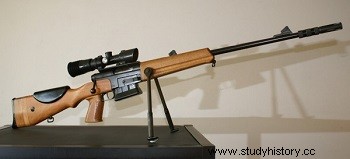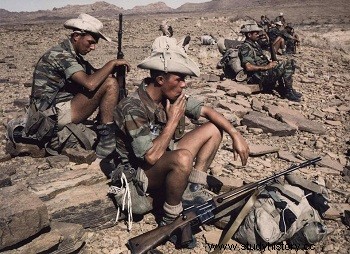
The FR-F1 (Fusil à Répétition model F1) is a French sniper rifle, in service from 1966 to 1989.
History
The FR-F1 was the first French rifle designed for snipers.
In 1964, General Ailleret instructed the General Staff of the Army to create a precision rifle. The preliminary studies are entrusted to the MAS which takes advice from sport shooters both from the military shooting sections and from the French Shooting Federation. After a pre-series of FR-P rifles, the new weapon was ready in 1966 and took the name FR-F1.

This weapon was in staffing in the French army from 1966 until in 1989 when it was replaced by the FR-F2. During its long service, the FR-F1 was equipped with various other optics, in particular of Schmidt and Bender brand of German origin (Marine Commandos), or SCROME of French origin (Army of Land then Air Force ), as well as SOPELEM OB 50 light amplification devices for night shooting, and its development gave birth to the FR-G 7.62 NATO caliber versions from 1993 on the initiative of GIAT.
The FR-F1 was used for the first time in operation by the GIGN during an intervention in Djibouti1, then by the foreign legion in Mauritania in 1977, by Moroccan troops against the Polisario Front and for the rescue of Kolwezi in Zaire in May 1978 to free European hostages.
Presentation
Country France
Ammunition 7.5×54mm 1929C and 7.62mm NATO
Manufacturer GIAT Industries
Service life 1966-1989
Weights and dimensions
Mass (unloaded) 5.125 kg
Length(s) 1,200 mm
Barrel length 600mm
Technical features
Mode of action Manual repeat
Practical range 800 m
Initial speed 780 m/s
Capacity 10 round magazine
Viewfinder Bezel
Variants FR-F2
Description
The FR-F1 has a bipod (non-pendulum, the pendulum bipod will appear on the FR-F2), a stock adjustable by set of pistol grip wedges and a telescopic sight.
The receiver is derived from that of the MAS 36, but it is more robust and has only an ejection window on the right (the parts of MAS 36 are compatible with an action of FR-F1 and FR-F2). The pistol grip stock has a cheek rest and pad spacers to adapt its length to the morphology of the shooter. A retractable metal bipod with lockable extendable legs is placed in the middle position, allowing long cycles of observation in firing positions without excessive fatigue of the right arm. The original rifle scope manufactured by APX and designated as the 806 L has a fixed magnification of 3.85 times and a center point reticle crossed by an interrupted center line. Adjusting the graduated elevation turret directly varies the height of the reticle in the objective.
The barrel, 600 millimeters in length, has four grooves on the right following a pitch of 300 and has at its end an adjustable flash suppressor sleeve absorbing muzzle exit vibrations. The 10-round metal magazine has a rubber heel allowing the weapon to be placed in immediate position without risk of damage to the case or noise allowing the location of the shooter. A leather carrying strap completes the U C (Packaging Unit) of the weapon, but operational users much prefer the "armed" position when traveling.
Variant
There are several versions of the FR-F1:
Version A:sniper weapon with modified APX 806 L scope, folding night sight, folding bipod with telescopic legs and trigger weight of 2 to 2.5 kg.
Version B:competition weapon with micrometric sight with eyepiece, front sight under tunnel with interchangeable visual, no bipod and trigger weight from 1.5 to 1.9 kg.
Version C:this version never went beyond the project stage, it was an F.R. F1 in civilian caliber intended for hunting and shooting (mounting of scope of version A or civilian equivalent to be chosen by the customer, line of folding sight allowing shooting up to 100 meters and night shooting, and a trigger weight of 2 to 2.5 kg).
